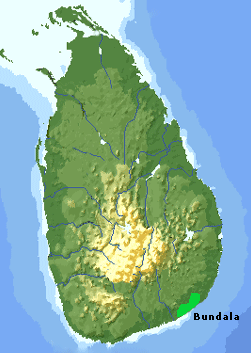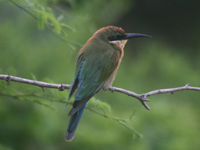|
|
| Accommodation Options |
|
|
To buy images on Sri Lanka Visit...... |
 |
|
| Comments from our Valued Clients |
"Campsite -Very Nice Site, Good Location,Food & Service -Excellent BBQ, great location for dinner, curry would be better for breakfast over mustard & cheese Sandwiches.Staff - Very Attentive and helpful, Personable, Knowledgable; Safari - Bundala: Very nice at night , Yala -Good Wildlife"
by Jeffery Kight
USA
Visited 23.12.2008 |
"The Naturalist is an expert. All the staff are so much caring, personally looked after great"
By Dhanuka Dickwella Visited 15/08/04 |
"I thought it was a trip to paradise. Thank you."
By Russell & Lynn Hunt Visited 09/09/05
|
"Thanks for sending the receipt of various payments made to you for the Rekawa Camping Expedition and Bandula National Park visit.
Please convey my thanks to Sudarshana, Roy and other members of the team who helped in making this trip memorable. The high quality professionalism and care displayed by your field-team under the guidance of Roy made our visit smooth and enjoyable.
I request you to convey our appreciation and heartfelt thanks to Roy , in particular.
With kind regards, Ravi
Ravi Pratap Singh
Visited 07/03/08 |
|
| |
|
Bundala National Park |

BUNDALA NATIONAL PARK is a unique area. The thorny scrub jungle is home to spotted deer, the rare pangolin and the playful grey langur monkey. A walk along the beach at dawn reveals unusual tracks in the sand. A sea turtle has come ashore to lay her eggs during the night. The picturesque lagoons and inter-tidal mud flats are alive with flashes of brilliant colour as wintering birds arrive to rest and feed.
Welcome to Bundala,the world at the edge where the land, the sea, and the wetlands meet.
|
 BUNDALA NATIONAL PARK, covering an area of 6216 hectares of eco tourism appeal, is located about 250km southeast of Colombo in the Hambantota district. The park falls within the southeastern arid zone of Sri Lanka, with a general climate that can be classified as hot and dry. The terrain is generally flat with sand dunes bordering the coastline, and vegetation consists mainly of dry thorny scrublands and lagoons. BUNDALA NATIONAL PARK, covering an area of 6216 hectares of eco tourism appeal, is located about 250km southeast of Colombo in the Hambantota district. The park falls within the southeastern arid zone of Sri Lanka, with a general climate that can be classified as hot and dry. The terrain is generally flat with sand dunes bordering the coastline, and vegetation consists mainly of dry thorny scrublands and lagoons.
The bio diversity of this park is immense: A total of 383 plant species have been recorded from the park, including 6 endemics and 7 species that are considered nationally threatened.
It is also home to 32 different species of mammal, 5 of which are classified as threatened. The bird life is also diverse. For keen bird-watchers, the complex wetland system harbours a rich bird life (approximately 197 species), including several species of migratory waterfowl. This has led to the declaration of the park as Sri Lanka 's first ‘Ramsar' wetland – one of great international importance especially for migratory waterfowl.
Read more about Bundala National Park ..... |
|
|
|
| History and the Description of the Bundala National Parks: |
 |
Bundala in the South East of Sri Lanka is a wonderful introduction to the country's National Parks. It is famous for its diversity and profusion of aquatic bird life which feed on the rich harvest provided by the numerous lagoons throughout the park.
It forms the most important wetland sanctuary, outside of the Northern Province, for migratory shore-birds including the Greater Flamingo. The park covers approximately 6000 hectares of brackish lagoons, salt pans, inter-tidal mudflats and thorny scrub jungle.
There is a small population of elephants which are fairly easy to spot in the open habitat; it is not unheard of to find one walking along the beach in perfect isolation. Leopards can also be found in the park preying on the numerous Spotted deer, Sambar and Barking deer.
Sightings are very rare but it is worth exploring several rocky outcrops where previous sightings have occurred. As well as leopards there are Sloth bears, Jackals, Giant squirrels, Indian pangolin and Civet cats. Marsh and estuarine crocodiles are both found in Bundala in addition to Monitor lizards and a variety of other reptiles. |
|
 Of the 150 bird species listed in the park, every species of water bird found in the country is said to visit here. The rare Black-necked stork and Great Thick-knee are particular birding highlights. It is easy to spot Blue-tailed Bee-eater, Spoonbill, Red Shank, Green Shank, Spot-billed Pelican, Blue-faced Malkoha, Brahminy Kite, Crested Hawk eagle and Brown Shrike, to name but a few. Migrants and vagrants make the journey from as far as Siberia ; over 10,000 shore birds might be feeding at any one time between October and March. Of the 150 bird species listed in the park, every species of water bird found in the country is said to visit here. The rare Black-necked stork and Great Thick-knee are particular birding highlights. It is easy to spot Blue-tailed Bee-eater, Spoonbill, Red Shank, Green Shank, Spot-billed Pelican, Blue-faced Malkoha, Brahminy Kite, Crested Hawk eagle and Brown Shrike, to name but a few. Migrants and vagrants make the journey from as far as Siberia ; over 10,000 shore birds might be feeding at any one time between October and March.
Along the coastal road leading from nearby Hambantota, where you will be based, to Bundala is another haven for wildlife with several more bird species to be seen.
 This coastal area also attracts four out of Sri Lanka 's five sea turtle species, which come ashore to lay their eggs. This park is much less visited than Yala, so largely avoids the weekend crowds. This coastal area also attracts four out of Sri Lanka 's five sea turtle species, which come ashore to lay their eggs. This park is much less visited than Yala, so largely avoids the weekend crowds.
A couple of days spent here is ideal before heading off to the nearby Udawalawe and Yala National Parks , or in conjunction with a beach stay at Tangalle or Mirissa.
The park is approximately five hours drive from Colombo along the coast. The average annual rainfall is relatively low and the 'dry season' falls between May and September.
|
CROCODILES IN BUNDALA |
 Bundala is the only National Park in Sri Lanka, where you get to observe both species of crocodiles existing in the country. A vast concentration of estuarine crocodiles live in the lagoon areas and in the estuary of the Kirindi Oya river, while the mugger or the freshwater crocodile dwells in the small freshwater lakes and in the upper regions of the Kirindi Oya. Bundala is the only National Park in Sri Lanka, where you get to observe both species of crocodiles existing in the country. A vast concentration of estuarine crocodiles live in the lagoon areas and in the estuary of the Kirindi Oya river, while the mugger or the freshwater crocodile dwells in the small freshwater lakes and in the upper regions of the Kirindi Oya.
The estuarine crocodile is the largest reptile alive today. The male of the species, grows to a length of seven metres and can weigh around 1200kg, with the female much smaller in comparison at around three metres in length.
 The female crocodile digs a hole in the sand several metres away from the water, lays around fifty eggs and provides protection to the nest by ensuring she stays close to the vicinity. When its time for the eggs to hatch, She is on hand to lend a helping hand to the new borns by carrying them to the water and also providing Motherly care until they are able to fend for themselves. The female crocodile digs a hole in the sand several metres away from the water, lays around fifty eggs and provides protection to the nest by ensuring she stays close to the vicinity. When its time for the eggs to hatch, She is on hand to lend a helping hand to the new borns by carrying them to the water and also providing Motherly care until they are able to fend for themselves.
Despite all this attention and care by the mother, the percentage of survival of these baby crocodiles is very sparse as they not only fall prey to turtles and other large fish but also to the adult male crocodiles who hunt them down to protect their own territory |
| |
| |
| It's man's world?? |
The temperature of the crocodile's nest determines the sex of the juveniles. If the temperature high, near 32.5C, the embryos are mostly males. As global warming continues, we could see some interesting changes in crocodile populations!
At 33 degrees C,80% of hatchling will be male
At 32 degrees C,80% of hatchling will be female
|
|
| |
The Estuarine or saltwater, crocodiles live in social groups. They spend most of their time trying to keep their body temperature constant. These crocodiles can swim large distances over open sea, which probably accounts for their wide distribution. |
| |
The mugger crocodile is found in fresh or brackish water. They like slow-moving, shallow water, making the lagoons of Bundala a perfect home. During the dry season muggers dig burrows in the mud to protect themselves from the heat, and they may travel long distances over land to find water if their pool dries up. |
| |
| What are they saying? |
The crocodile is considered one of the most interlligent reptiles.Their different calls are a specialized means of communication.A hatchling chrip alerts the female when offspring are ready to emerge.Juvenile crocs perform a distress call when they feel in danger, and a long, low growl is a courtship bellow.
The most important croc song for humans to learn is a hiss or cough.If you hear this coming from the marsh,Look out! It is the call crocs use to warn off intruders just before they attack. |
| |
|
|